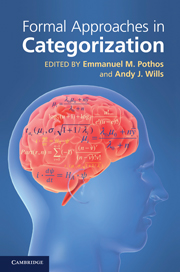Book contents
- Frontmatter
- Contents
- List of figures
- List of tables
- List of contributors
- 1 Introduction
- 2 The generalized context model: an exemplar model of classification
- 3 Prototype models of categorization: basic formulation, predictions, and limitations
- 4 COVIS
- 5 Semantics without categorization
- 6 Models of attentional learning
- 7 An elemental model of associative learning and memory
- 8 Nonparametric Bayesian models of categorization
- 9 The simplicity model of unsupervised categorization
- 10 Adaptive clustering models of categorization
- 11 Cobweb Models of Categorization and Probabilistic Concept Formation
- 12 The knowledge and resonance (KRES) model of category learning
- 13 The contribution (and drawbacks) of models to the study of concepts
- 14 Formal models of categorization: insights from cognitive neuroscience
- 15 Comments on models and categorization theories: the razor's edge
- Index
- References
6 - Models of attentional learning
Published online by Cambridge University Press: 05 June 2012
- Frontmatter
- Contents
- List of figures
- List of tables
- List of contributors
- 1 Introduction
- 2 The generalized context model: an exemplar model of classification
- 3 Prototype models of categorization: basic formulation, predictions, and limitations
- 4 COVIS
- 5 Semantics without categorization
- 6 Models of attentional learning
- 7 An elemental model of associative learning and memory
- 8 Nonparametric Bayesian models of categorization
- 9 The simplicity model of unsupervised categorization
- 10 Adaptive clustering models of categorization
- 11 Cobweb Models of Categorization and Probabilistic Concept Formation
- 12 The knowledge and resonance (KRES) model of category learning
- 13 The contribution (and drawbacks) of models to the study of concepts
- 14 Formal models of categorization: insights from cognitive neuroscience
- 15 Comments on models and categorization theories: the razor's edge
- Index
- References
Summary
Many theories of learning provide no role for learned selective attention (e.g., Anderson, 1991; Pearce, 1994; Rehder & Murphy, 2003). Selective attention is crucial, however, for explaining many phenomena in learning. The mechanism of selective attention in learning is also well motivated by its ability to minimize proactive interference and enhance generalization, thereby accelerating learning. Therefore, not only does the mechanism help explain behavioural phenomena, it makes sense that it should have evolved (Kruschke & Hullinger, 2010).
The phrase ‘learned selective attention’ denotes three qualities. First, ‘attention’ means the amplification or attenuation of the processing of stimuli. Second, ‘selective’ refers to differentially amplifying and/or attenuating a subset of the components of the stimulus. This selectivity within a stimulus is different from attenuating or amplifying all aspects of a stimulus simultaneously (cf. Larrauri & Schmajuk, 2008). Third, ‘learned’ denotes the idea that the allocation of selective processing is retained for future use. The allocation may be context sensitive, so that attention is allocated differently in different contexts.
There are many phenomena in human and animal learning that suggest the involvement of learned selective attention. The first part of this chapter briefly reviews some of those phenomena. The emphasis of the chapter is not the empirical phenomena, however. Instead, the focus is on a collection of models that formally express theories of learned attention. These models will be surveyed subsequently.
- Type
- Chapter
- Information
- Formal Approaches in Categorization , pp. 120 - 152Publisher: Cambridge University PressPrint publication year: 2011
References
- 14
- Cited by

